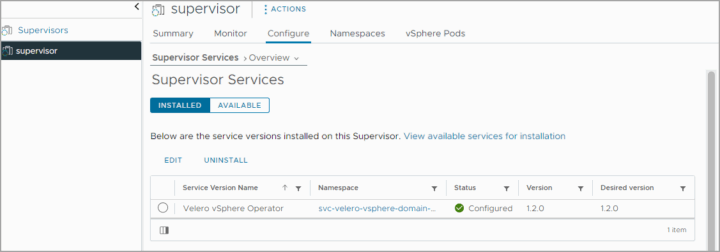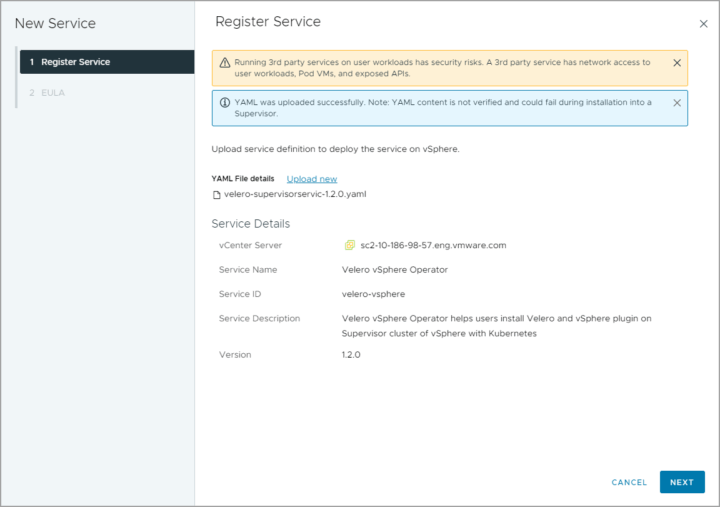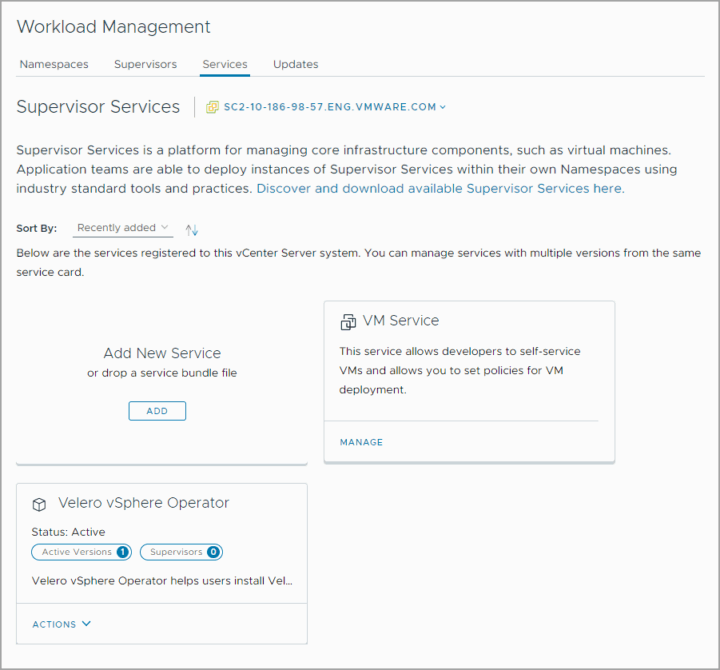Welcome back to our VMware Certified Professional – VMware vSphere Foundation Administrator (2V0-16.25) study guide series! We follow the official VMware Blueprint for the exam – VMware vSphere Foundation Administrator (PDF). This section is part of the upcoming VCP-VVF Study Guide Page, which will be released as a PDF when completed—check it out at https://www.vladan.fr/vcp-vvf-administrator/. Today, we’re kicking off Objective 4.4 – VVF: Consume and Automate, focusing on Given a scenario, describe the deployment of Supervisor-based Services in VMware vSphere Foundation.
In VMware vSphere Foundation (VVF) 9.0, Supervisor-based Services leverage the vSphere with Tanzu Supervisor to deliver Kubernetes-based workloads, enabling modern application deployment alongside traditional VMs in the Software-Defined Data Center (SDDC). Understanding how to deploy these services is critical for managing containerized workloads.
This objective is essential for the 2V0-16.25 exam, testing your ability to describe the deployment process for Supervisor-based Services in real-world scenarios. Building on our previous posts (Objective 4.2, Parts 1-4, covering VVF management tasks, and Objective 4.3, Parts 1-19, covering VCF Operations setup, monitoring, dashboards, log analysis, costing, integrations, vSAN monitoring, policies, application monitoring, Service Discovery, compliance, and VCF Operations for Logs), we’ll provide a detailed description of deploying Supervisor-based Services, practical insights, and exam-focused guidance using a realistic scenario, aligned with VMware’s official vSphere 9.0 and VCF 9.0 documentation (https://techdocs.broadcom.com/us/en/vmware-cis/vsphere/vsphere/9-0.html and https://techdocs.broadcom.com/us/en/vmware-cis/vcf/vcf-9-0-and-later/9-0/tanzu-operations.html). Let’s dive into Supervisor-based Services in VVF!
Why Deploying Supervisor-based Services Matters
In VVF 9.0, Supervisor-based Services, part of vSphere with Tanzu, allow administrators to deploy and manage Kubernetes workloads (e.g., pods, services) on a Supervisor cluster integrated with vSphere infrastructure. These services enable developers to consume containerized applications while leveraging vSphere features like vSAN, NSX, and VCF Operations for monitoring. Objective 4.4 tests your ability to describe the deployment process for Supervisor-based Services in scenarios involving modern application delivery. This chapter (Part 20) focuses on a scenario requiring you to outline the deployment process, complementing Part 19 (VVF component integrations) and Part 18 (VCF Operations for Logs).
Describing the Deployment of Supervisor-based Services
Below, we detail the process for deploying Supervisor-based Services in VVF 9.0, including prerequisites, configuration steps, and validation, while ensuring no workload disruptions. The content is verified against VMware vSphere 9.0 and VCF 9.0 documentation (https://techdocs.broadcom.com/us/en/vmware-cis/vsphere/vsphere/9-0/tanzu-kubernetes-grid.html and https://techdocs.broadcom.com/us/en/vmware-cis/vcf/vcf-9-0-and-later/9-0/tanzu-operations.html).
Understanding Supervisor-based Services
Description: Supervisor-based Services are Kubernetes services (e.g., deployments, pods, services) running on a Supervisor cluster, which is a vSphere with Tanzu component that integrates Kubernetes with vSphere infrastructure. The Supervisor cluster, already enabled in “VVF-Cluster” (per Objective 4.1, Part 3), manages namespaces like “Microservices-Namespace” and supports containerized workloads like “Web-App”.
Key Components:
- Supervisor Cluster: A vSphere cluster with Tanzu enabled, running control plane VMs and managing namespaces.
- Namespace: A logical boundary (e.g., “Microservices-Namespace”) for deploying services, with resource and access controls.
- Supervisor Services: Kubernetes resources (e.g., pods, services, ingress) deployed within a namespace.
- Integration: Leverages vSAN for storage, NSX for networking, and VCF Operations for monitoring (per Part 19).
VMware vSphere Supervisor is the foundation of VCF consumption and can be enabled during workload domain creation or directly in vCenterIt transforms vSphere clusters into modern application platforms by embedding a platform-level Kubernetes control plane directly into ESX hosts, exposing a unified declarative API surface. This integration allows end users to provision and manage workloads, including VMs, containers via vSphere Pods, full Kubernetes clusters through VKS, OCI image registries, and data services through a consistent API interface.
Documentation Reference: Supervisor-based Services are detailed in the vSphere 9.0 documentation under “Tanzu Kubernetes Grid” https://techdocs.broadcom.com/us/en/vmware-cis/vsphere/vsphere/9-0/tanzu-kubernetes-grid.html.
Deployment options
Single-Zone Deployment – A Single-Zone Supervisor deployment uses a single vSphere cluster to host both workloads and Supervisor management components. It can be enabled either during the workload domain creation process or via the Supervisor Enablement workflow in vCenter. Additional vSphere Zones can be added after initial enablement. However, these zones are used exclusively for workload placement and do not host Supervisor control plane components.
Multi-Zone Deployment – A Multi-Zone Supervisor deployment uses three vSphere clusters, placing each cluster into a vSphere Zone. vSphere Zones are used by workloads and Supervisor management components to deliver high availability and expose each cluster as an independent, consumable availability zone. This configuration provides a resilient, HA-capable platform.
Additional vSphere Zones can be added after initial enablement. However, these additional zones are available for workload consumption only, not for Supervisor control plane components.
Single Host – Also a Single-Zone Supervisor with a single Control Plane VM deployed to a single ESX host, with vSphere HA disabled. While it shares the same characteristics as other single-zone deployments, in this configuration, any host failure results in downtime for the Supervisor Control Plane and potentially for associated workloads.
Easy Supervisor – This is a Single-Zone simplified deployment that uses workload networking on top of vSphere Distributed Switch, designed as a fast and simple starting point for proof-of-concept environments and production deployments leveraging vSphere Distributed Switch.
For more information, see Deploying Supervisor with a Simplified Deployment Flow.
An Easy Supervisor deployment consists of:
- One Supervisor Control Plane VM
- A shared network for both workload and management traffic
- No load balancer
- You can deploy only VMs. Additional services, such as VKS, can be enabled by configuring a load balancer after the initial deployment.
- You cannot use this deployment option with VCF Automation.
Install supervisor service on a supervisor (VMware Documentation).
Adding supervisor services
- From the vSphere Client home menu, select Supervisor Management.
- Select Services.
- Select a vCenter system from the drop-down menu at the top.
- Drag and drop the service YAML file in the Add New Service card.
- Click Next and accept the EULA if any.
- Click Finish.
- The Supervisor Service and all of its information is registered with the vCenter system. The service is in Active state.
Install the Supervisor Service on Supervisors so that your DevOps engineers can use it in Kubernetes workloads. See Install a Supervisor Service on a Supervisor.
Study Tip: Practice deploying Supervisor-based Services in VMware Hands-On Labs https://labs.hol.vmware.com/. Memorize the Supervisor cluster components, namespace setup, and YAML deployment process.
Sample Exam Questions
- What is the purpose of Supervisor-based Services in VVF 9.0?
A. Deploy traditional VMs
B. Run Kubernetes workloads on a Supervisor cluster
C. Configure vSAN disk groups
D. Manage NSX firewall rules
Answer: B. Run Kubernetes workloads on a Supervisor cluster. - What is a prerequisite for deploying Supervisor-based Services?
A. Disable vSphere HA
B. Configure a namespace with a vSAN storage policy
C. Remove NSX integration
D. Disable VCF Operations
Answer: B. Configure a namespace with a vSAN storage policy. - How do you verify a Supervisor-based Service deployment?
A. Check vSAN health in vCenter
B. Use kubectl to confirm pod status and VCF Operations for metrics
C. Edit DRS settings in the cluster
D. Create a vSAN storage policy
Answer: B. Use kubectl to confirm pod status and VCF Operations for metrics.
Final Words
Deploying Supervisor-based Services in VMware vSphere Foundation 9.0 enables modern Kubernetes workloads alongside traditional VMs in the SDDC. Stay tuned for the next part of Objective 4.4 or 4.3! Happy studying, and good luck on your VCP-VVF journey!
More posts from ESX Virtualization:
- 5 New VMware Certifications for VVF and VCF
- VMware Alternative – OpenNebula: Powering Edge Clouds and GPU-Based AI Workloads with Firecracker and KVM
- Proxmox 9 (BETA 1) is out – What’s new?
- Another VMware Alternative Called Harvester – How does it compare to VMware?
- VMware vSphere 9 Standard and Enterprise Plus – Not Anymore?
- VMware vSphere Foundation (VVF 9) and VMware Cloud Foundation (VCF 9) Has been Released
- Vulnerability in your VMs – VMware Tools Update
- VMware ESXi FREE is FREE again!
- No more FREE licenses of VMware vSphere for vExperts – What’s your options?
- VMware Workstation 17.6.2 Pro does not require any license anymore (FREE)
- Migration from VMware to another virtualization platform with Veeam Backup and Replication
- Two New VMware Certified Professional Certifications for VMware administrators: VCP-VVF and VCP-VCF
- Patching ESXi Without Reboot – ESXi Live Patch – Yes, since ESXi 8.0 U3
- Update ESXi Host to the latest ESXi 8.0U3b without vCenter
- Upgrade your VMware VCSA to the latest VCSA 8 U3b – latest security patches and bug fixes
- VMware vSphere 8.0 U2 Released – ESXi 8.0 U2 and VCSA 8.0 U2 How to update
- What’s the purpose of those 17 virtual hard disks within VMware vCenter Server Appliance (VCSA) 8.0?
- VMware vSphere 8 Update 2 New Upgrade Process for vCenter Server details
- VMware vSAN 8 Update 2 with many enhancements announced during VMware Explore
- What’s New in VMware Virtual Hardware v21 and vSphere 8 Update 2?
- vSphere 8.0 Page
- ESXi 7.x to 8.x upgrade scenarios
- VMware vCenter Server 7.03 U3g – Download and patch
- Upgrade VMware ESXi to 7.0 U3 via command line
- VMware vCenter Server 7.0 U3e released – another maintenance release fixing vSphere with Tanzu
- What is The Difference between VMware vSphere, ESXi and vCenter
- How to Configure VMware High Availability (HA) Cluster




Leave a Reply